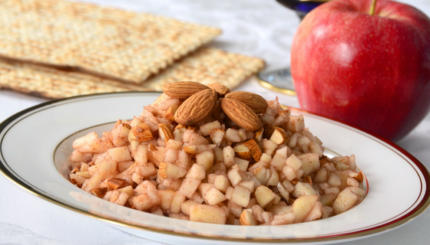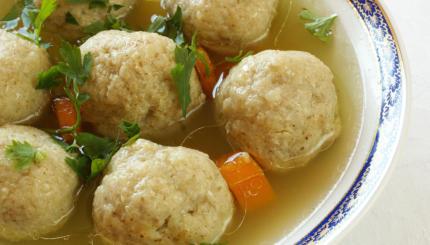Watch how to make Moroccan-style charoset here.
Haroset is the star of the seder plate. Amidst the parsley leafs and lamb shanks, this sweet sticky treat teases and tantalizes as we make our way through the story telling. Charoset recalls the mortar used by the Israelites when they were slaves. Jews, spread over the four corner of the earth, and brought the story of the Exodus and the celebration of Passover to every land.
With time, the recipes for haroset reflected local ingredients and tastes. Whether you make one, two or all of the seven classic and modern recipes we have collected, we doubt that you will be able to wait until the seder to taste these outstanding haroset!
Uganda: Tziporah Sizomu’s Haroset Recipe
Tziporah Sizomu is a leader in the Abayudaya community in Uganda. Passover is an especially meaningful holiday for the Abayudaya. Her husband Gershom is the community rabbi and Tziporah is responsible for the Shabbat and holiday meals that are eaten together by the Abayudaya as a community. Apples are expensive, as they must be imported from South Africa, while peanuts, known as groundnuts, are local to Uganda. This haroset makes a fabulous spread for Matzah all week long! (Note: peanuts are legumes and there are some Jews who do not eat them during Passover. They can be replaced them with cashews.)
Ingredients
4 cups roasted peanuts
3 apples, chopped fine
2 bananas, chopped into small pieces
1/2 cup honey
1/2 cup sweet wine
Directions
Grind the peanuts in a blender and place them in a medium-sized bowl. Rural Ugandans use a mortar and pestle. They don’t have blenders as very few have electricity.
Mix with the chopped apples and bananas.
Add the wine and stir.
Add the honey and mix everything together. (If it isn’t thick enough, add more peanuts)
Syria: Meil Family Recipe, Haroset Halebieh
Originally from Philadelphia, Heather and Jason Meil have been living in the Bay Area for the past 10 years and are active members at Oakland’s Temple Sinai. This recipe was passed down from Jason’s great-grandmother, Jammila Dweck Marcus who was born in Allepo, Syria to his grandmother, Leah (born in the Sudan) to his mother, Joan. It has been in the family for generations and makes an appearance yearly at the Meil seder.
Ingredients
3 pounds pitted dates
1 cup sweet red wine
1 t ground cinnamon (optional)
1 cup chopped walnuts (optional)
Directions
Put the dates in a medium saucepan with enough water to cover.
Bring to a boil, lower the heat and simmer.
Stir frequently, until the dates are soft.
Pass the date mixture through a strainer or a rotary grader. A food processor may also be used.
Before serving, add the wine, cinnamon and walnuts and mix thoroughly.
Greece: Traditional Greek Haroset Recipe
Sarah Aroeste’s familial roots in Greece trace all the way back to the expulsion of Jews from Spain. A vocal artist, she has dedicated her career to modernizing Ladino classics and creating new music that captures the vibrancy of the Sephardic experience. For Passover, she draws on traditional Greek customs and makes this fruity recipe that gets its punch from a variety of spices.
Ingredients
1 cup black currants, finely chopped
1 cup raisins, finely chopped
1 cup dates, finely chopped and then mashed (if they are very dry soak them in boiling water for 10 minutes)
Pinch of grated orange rind
Cinnamon, allspice, cloves, nutmeg to taste
Sweet red wine
Directions
Chop all the ingredients as fine as possible.
Mash them into a paste in a mortar and pestle. Or briefly process in food processor.
Moisten as necessary with the red wine.
Makes 3 cups
Guatemala, Two Ways: Modern Twist
The members of Adat Shalom, Guatemala’s only Reform community have created a unique take on haroset. It was a big hit at last year’s seder in Guatemala City and it will be at yours too.
Ingredients:
4 apples, peeled, cored, and finely chopped
1/2 cup sweet red wine (such as Manischewitz)
1 1/2 teaspoons ground cinnamon
3 tablespoon maple syrup
5 oz of refried red beans
4 oz of chopped almonds
Directions
Chop the apples by hand as finely as possible and press them with a fork.
Add the rest of the ingredients. mixing everything well.
Beans should be added at the end, depending on how juicy the apple is so that the charoset thicken.
After plating, add a little of the almonds as decoration.

Brenda Rosenbaum’s Haroset
Brenda Rosenbaum, is the founder of Mayan Hands. She grew up in Guatemala and left as a young adult due to the civil war. Her family is half Ashkenazi and half Sephardic. Her mother lives in Guatemala City and this is her recipe. This recipe came via Ilana Schatz of Fair Trade Judaica.
Ingredients:
1 pound dates
2 granny smith apples
Cinnamon
Sweet wine
1 cup chopped nuts (macadamia nuts are native to Guatemala)
Directions
Soak dates in hot water for a few hours.
Drain the dates but put them in the food processor but don’t process them completely, leave some chunks in it.
Peal and cut apples into one inch chunks.
Put apple pieces in pan, and bring to boil with a bit of water. Simmer until they become puree.
Mix dates and apples.
Add cinnamon to taste, sweet wine.
Just prior to serving add chopped nuts.
Cuba: Mango and Pineapple Haroset Balls
For Jennifer “The Cuban Reuben” Stempel blogging about food allows her to explore her twin Jewish and Cuban heritages. This Cuban haroset is her own invention inspired by the island flavors that influence so much of her cooking. While most haroset is served as a paste, Stempel drew on the Sephardic tradition of making haroset into small balls for this unique take on a classic dish.
Ingredients:
5oz dried unsweetened mango, coarsely chopped
8oz dried unsweetened pineapple, coarsely chopped
½ cup almond slivers, toasted
2 cups shredded coconut, toasted and separated
Directions:
In a small bowl, soak the mango in hot water for ½ hour.
Drain well, and add to a food processor. Add pineapple, almonds, and 1 cup of the coconut to the mango in the food processor, and pulse only until the mixture starts to form a ball. There should still be some visible chunks.
Form the mixture into bite-sized balls, and set atop a pan lined with wax paper.
In a small bowl, add the last cup of shredded coconut. Roll the balls in the coconut until they are lightly coated, and return them to the wax paper.
Refrigerate the balls for 1 hour or until set.
United States: Rabbi Ruth’s Haroset Recipe
One of the joys of Jewish life in America is the diversity not only of the community but also of the ingredients from around the world that are at our fingertips. This recipe draws on traditional as well as exotic flavors. Sweet with a touch of the sour with a red tinge which reminds us of the mixed emotions with which we greet our freedom, always recalling the hard work and suffering that preceded the Exodus.
Ingredients:
1 cup dried figs
1 cup dried apricots
1 cup roasted hazelnuts
1 large or 2 small whole blood oranges
2 tablespoons pomegranate molasses (available at Middle Eastern markets)
Additional orange juice as needed
Directions
Cut blood oranges into quarters or chunks depending on size.
Place all the ingredients except the orange juice in food processor
Pulse until mixture resembles a paste.
If mixture is too dry add a tablespoon of additional orange juice and pulse again.
Repeat until the mixture is moist.
Ashkenazi
Pronounced: AHSH-ken-AH-zee, Origin: Hebrew, Jews of Central and Eastern European origin.
seder
Pronounced: SAY-der, Origin: Hebrew, literally “order”; usually used to describe the ceremonial meal and telling of the Passover story on the first two nights of Passover. (In Israel, Jews have a seder only on the first night of Passover.)
Sephardic
Pronounced: seh-FAR-dik, Origin: Hebrew, describing Jews descending from the Jews of Spain.
Shabbat
Pronounced: shuh-BAHT or shah-BAHT, Origin: Hebrew, the Sabbath, from sundown Friday to sundown Saturday.



